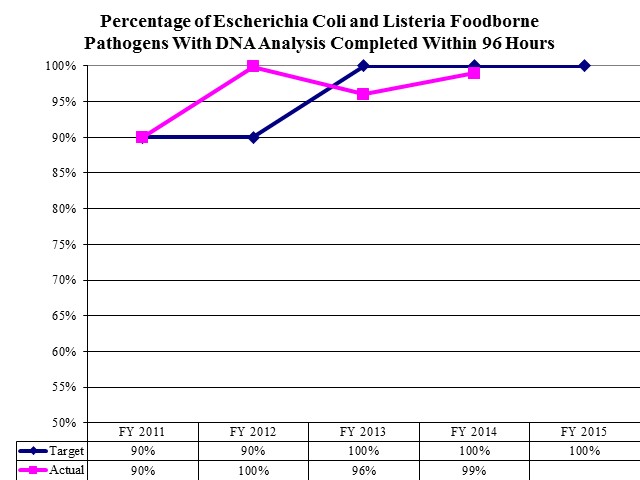The four main goals of the Utah Public Health Laboratory are to: 1) produce accurate and timely testing in a wide range of public health disciplines, 2) provide expert scientific consultation, 3) collaborate with our partners to improve public health outcomes, and 4) deliver education and training to advance public health laboratory science.
During the 2015 General Session, the Legislature appropriated for Fiscal Year 2016, $700 from all sources for Public Health Laboratory. This is a 0 percent increase from Fiscal Year 2015 revised estimated amounts from all sources.
Infectious Diseases Program
The Chemical and Environmental Services Laboratory provides testing of water, soil, and air for toxic contaminants to enable our partners to monitor the environment for compliance with health and safety standards, and to respond to emergencies such as chemical spills and contaminated drinking water. The testing and results, requested primarily by the Department of Environmental Quality and the Department of Natural Resources, assist those departments in assessing the safety of the environment. The Bureau also serves private agencies. The United States Environmental Protection Agency certifies the State laboratory as the principal laboratory for water testing.
The infectious diseases program provides laboratory testing and consultation services for local health departments; hospitals, clinical, laboratories, and physicians throughout Utah; the Utah. The areas of support include: sexually-transmitted diseases (HIV, syphilis, chlamydia, and gonorrhea), agents of bioterrorism surveillance, respiratory virus surveillance and subtyping, arbovirus surveillance, virology, rabies testing, bacteriology, mycobacteriology, as well as communicable disease outbreak support, i.e. - influenza, tuberculosis, and food borne diseases.
Newborn Screening Laboratory
The Newborn Screening Program, together with partner laboratories, screens all newborns in Utah for 38 conditions. This program is funded entirely through dedicated credit revenue from the pre-sale of blood-spot collection kits.
Laboratory Operations
The laboratory operations support services provide specimen handling, client services, and data entry. It includes purchasing, a central supply and distribution center, sterilization, collection kit preparation, physical plant operations, and employee support.
Chemical and Environmental Services Laboratory
The Chemical and Environmental Services Laboratory provides testing of water, soil, and air for toxic contaminants to enable our partners to monitor the environment for compliance with health and safety standards, and to respond to emergencies such as chemical spills and contaminated drinking water. The testing and results, requested primarily by the Department of Environmental Quality and the Department of Natural Resources, assist those departments in assessing the safety of the environment. The Bureau also serves private agencies. The United States Environmental Protection Agency certifies the State laboratory as the principal laboratory for water testing.
The laboratory program also tests for chemical agents in clinical samples in response to chemical terrorism incidents as a result of federal funding from the Center for Disease Control and Prevention (CDC) for the Public Health and Preparedness Program. The laboratory tests and analyzes heavy metals, cyanide, volatile organic chemicals, tetramine, and other toxic chemicals in samples to determine exposure of these chemicals to humans.
Forensic Toxicology Laboratory
The Forensic Toxicology Laboratory provides drug and alcohol analysis for law enforcement agencies to determine driving under the influence violations, including automobile homicides, sexual assaults, and other crimes. In addition, the Bureau provides testing for drug, alcohol, and other poisons in autopsy specimens to assist the Office of the Medical Examiner in determining the cause of death. Additionally, Bureau staff provide expert witness testimony on alcohol and drug impairment in courts statewide.
Certification Programs
The mission of the Environmental Certification Program and Clinical Laboratory Improvement Amendments Certification Programs is to improve the quality of test results produced in clinical and environmental laboratories through consultation, training, and certification. These two programs establish and enforce standards for laboratories performing tests that impact public health. The programs inspect and certify all clinical laboratories in Utah. They also inspect and certify all environmental laboratories that submit laboratory data to the Utah Department of Environmental Quality.
COBI contains unaudited data as presented to the Legislature by state agencies at the time of publication. For audited financial data see the State of Utah's Comprehensive Annual Financial Reports.
